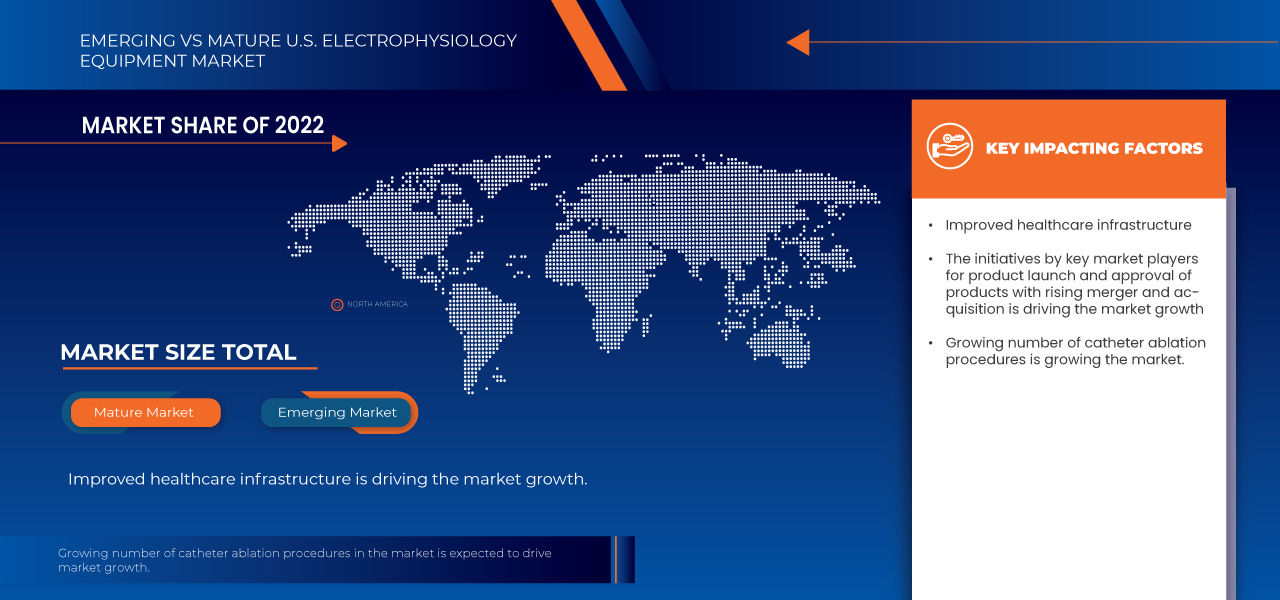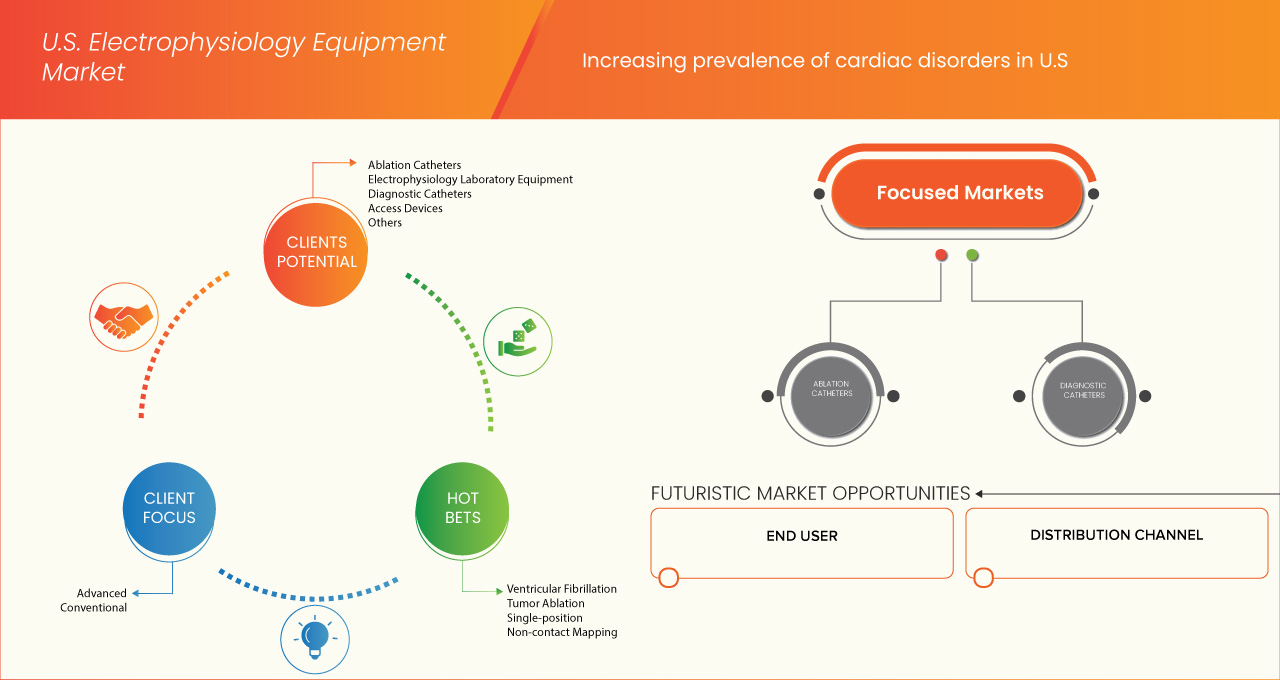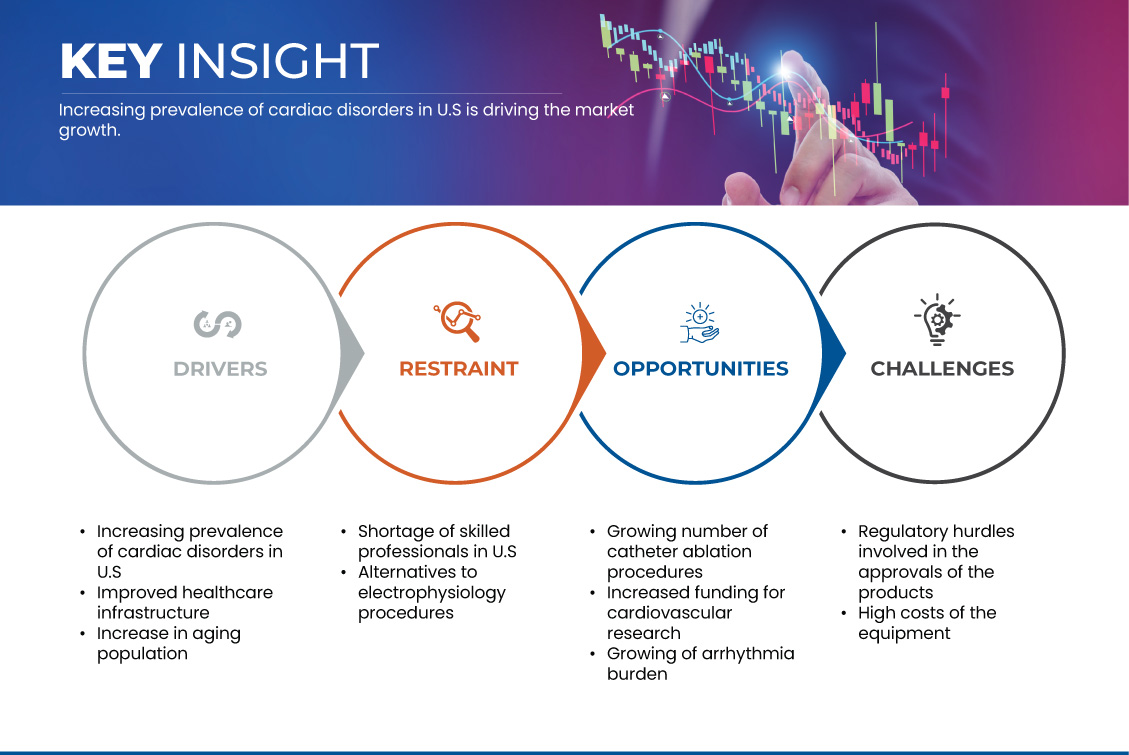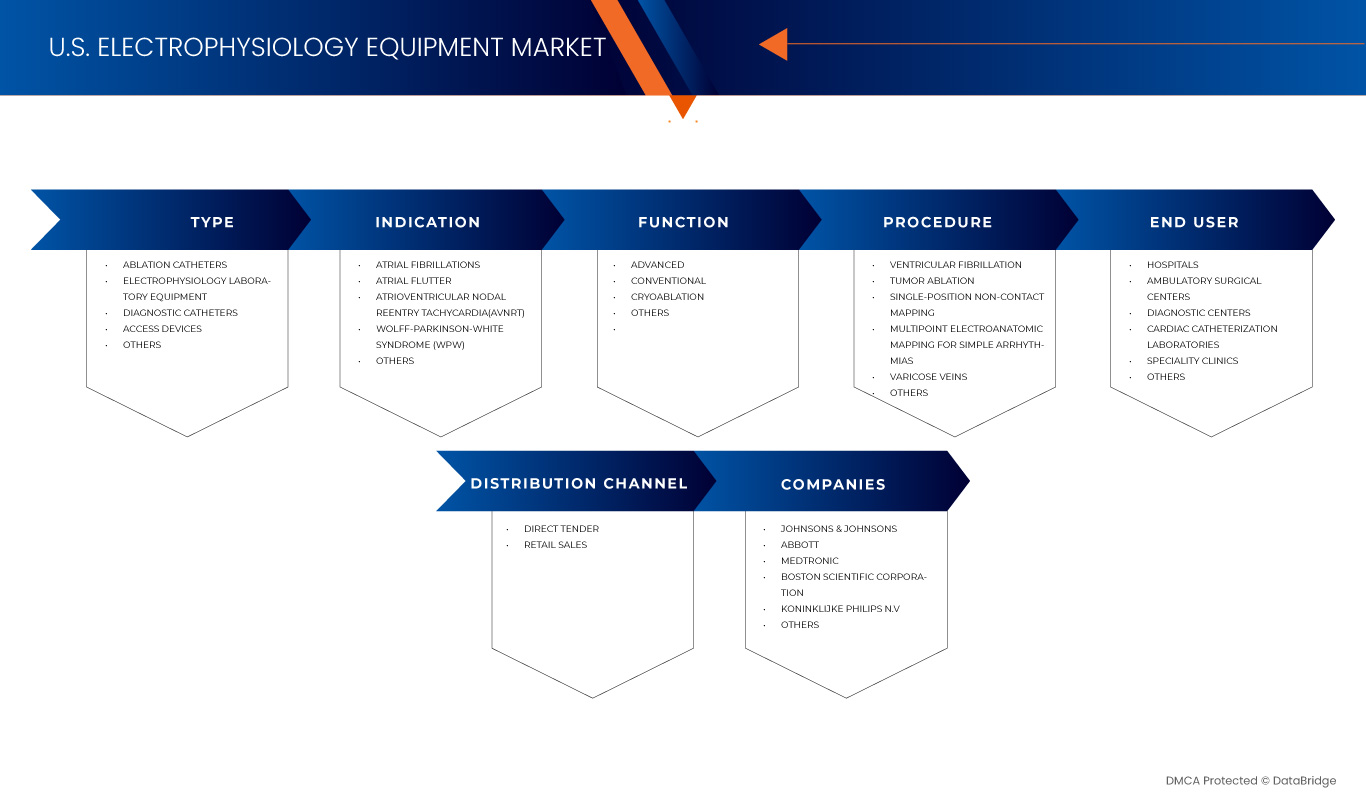Us Electrophysiology Equipment Market
Tamanho do mercado em biliões de dólares
CAGR :
% 
| 2025 –2032 | |
| USD 5.08 Billion | |
| USD 9.60 Billion | |
|
|
|
U.S. Electrophysiology Equipment Market, By Type (Ablation Catheters, Electrophysiology Laboratory Equipment, Diagnostic Catheters, Access Devices, and Others), Indication (Atrial Fibrillation, Atrial Flutter, Atrioventricular Nodal Reentry Tachycardia(AVNRT), Wolff-Parkinson-White Syndrome (WPW), and Others), Function (Advanced, Conventional, Cryoablation, and Others), Procedure (Ventricular Fibrillation, Tumor Ablation, Single-Position Non-Contact Mapping, Multipoint Electroanatomic Mapping for Simple Arrhythmias, Varicose Veins, and Others), End User (Hospitals, Ambulatory Surgical Centers, Diagnostic Centers, Cardiac Catheterization Laboratories, Speciality Clinics, and Others), Distribution Channel (Direct Tender and Retail Sales) – Industry Trends and Forecast to 2032
U.S. Electrophysiology Equipment Market Analysis
The history of Electrophysiology (EP) Equipment dates back to the mid-20th century, when advances in cardiology began to reveal the electrical nature of heart function. Initial developments included basic cardiac monitors and early pacemakers in the 1950s, which paved the way for more sophisticated devices. The 1960s and 1970s saw the introduction of electrocardiography (ECG) machines and the advent of catheter ablation techniques, allowing for targeted treatment of arrhythmias. Over the years, innovations such as three-dimensional mapping systems, advanced imaging techniques, and automated electrophysiology systems have significantly enhanced the precision and safety of procedures. By the late 1990s and into the 2000s, the integration of computer technology and improved understanding of cardiac anatomy led to the development of state-of-the-art EP labs equipped with specialized mapping and recording systems. Today, electrophysiology equipment continues to evolve, incorporating advanced technologies like artificial intelligence and minimally invasive approaches, thus transforming the management of cardiac arrhythmias and improving patient outcomes.
U.S. Electrophysiology Equipment Market Size
The U.S. electrophysiology equipment market is expected to reach USD 9.60 billion by 2032 from USD 5.08 billion in 2024, growing at a CAGR of 8.3% in the forecast period of 2025 to 2032. In addition to the insights on market scenarios such as market value, growth rate, segmentation, geographical coverage, and major players, the market reports curated by the Data Bridge Market Research also include import export analysis, production capacity overview, production consumption analysis, price trend analysis, climate change scenario, supply chain analysis, value chain analysis, raw material/consumables overview, vendor selection criteria, PESTLE Analysis, Porter Analysis, and regulatory framework.
U.S. Electrophysiology Equipment Market Trends
“Increasing Adoption of Advanced Technologies”
One notable trend in the U.S. electrophysiology equipment market is the increasing adoption of advanced technologies such as 3D mapping systems and electrophysiology catheters, driven by the growing prevalence of cardiac arrhythmias and advancements in minimally invasive procedures. This shift is largely propelled by the demand for improved diagnostic accuracy and treatment efficacy, enabling healthcare providers to offer personalized and targeted therapies. Additionally, the integration of artificial intelligence and machine learning within these technologies is enhancing real-time data analysis and procedural outcomes, further driving market growth. As healthcare facilities continue to invest in state-of-the-art electrophysiology systems, this trend underscores a broader movement towards more specialized and technologically sophisticated cardiac care solutions in the U.S. healthcare landscape.
Report Scope and U.S. Electrophysiology Equipment Market Segmentation
|
Attributes |
U.S. Electrophysiology Equipment Market Insights |
|
Segments Covered |
|
|
Key Market Players |
Johnsons & Johnsons(U.S.), Abbott(U.S.), Medtronic(Ireland), Boston Scientific Corporation(U.S.), and Koninklijke Philips N.V. (U.S.) |
|
Market Opportunities |
|
|
Value Added Data Infosets |
In addition to the insights on market scenarios such as market value, growth rate, segmentation, geographical coverage, and major players, the market reports curated by the Data Bridge Market Research also include import export analysis, production capacity overview, production consumption analysis, price trend analysis, climate change scenario, supply chain analysis, value chain analysis, raw material/consumables overview, vendor selection criteria, PESTLE Analysis, Porter Analysis, and regulatory framework. |
U.S. Electrophysiology Equipment Market Definition
Electrophysiology equipment refers to a specialized set of medical devices and instruments used to diagnose and treat electrical activities of the heart, particularly in relation to arrhythmias and other cardiac disorders. This category includes tools such as electrophysiology catheters, which are inserted into the heart to record electrical signals; mapping systems, which visualize the electrical activity and help pinpoint areas of abnormal conduction; and ablation devices, which are employed to destroy or isolate problematic tissue responsible for irregular heart rhythms. With advancements in technology, electrophysiology equipment increasingly incorporates features like 3D mapping, remote navigation, and real-time data analysis, enhancing the precision and efficacy of cardiac procedures.
U.S. Electrophysiology Equipment Market Dynamics
Drivers
- Increasing Prevalence of Cardiac Disorders in U.S.
The increasing prevalence of cardiac disorders in the U.S., especially arrhythmias such as atrial fibrillation, heart block, and ventricular tachycardia, is a key driver for the electrophysiology equipment market. With rising rates of lifestyle-related conditions like hypertension, diabetes, and obesity, the incidence of heart rhythm disorders has surged in recent years. This growing burden on the healthcare system necessitates the use of advanced diagnostic and therapeutic tools, such as electrophysiology devices, to effectively diagnose, monitor, and treat these conditions. As more patients seek treatments like catheter ablation and other electrophysiology procedures to manage their conditions, the demand for high-performance EP equipment increases, driving both innovation and adoption within the market. This rise in demand for effective treatment options directly propels market growth, making the increasing prevalence of cardiac disorders a crucial driver for the electrophysiology equipment sector.
In October 2024, according to the article published by Centers for Disease Control and Prevention, Coronary heart disease (CHD), the most common heart condition, claimed 371,506 lives in 2022. Approximately 1 in 20 adults over 20 years old are affected by CHD, and 1 in 5 cardiovascular disease-related deaths occur in adults under 65. This high and rising prevalence of coronary artery disease significantly drives the demand for electrophysiology equipment used in diagnosis and treatment, fueling market growth
- Improved Healthcare Infrastructure
The expansion of hospitals, Academic Medical Centers (AMCs) collaborations with smaller community hospitals are pivotal factors driving the U.S. electrophysiology equipment market. As AMCs and large hospital networks enhance their facilities and invest in specialized cardiac care, they set the standard for advanced treatment, often sharing technology and expertise with smaller community hospitals. These collaborations ensure broader access to cutting-edge diagnostic and treatment options, including electrophysiology devices. The Affordable Care Act (ACA) has further facilitated this trend by expanding healthcare access, particularly for underserved populations. As more patients gain access to advanced cardiovascular care, the demand for electrophysiology equipment rises, stimulating market growth and innovation in the sector.
For instance-
In April 2024, according to the article published by American Heart Association, Inc., the ACA addresses Medicaid expansion that enhanced access to primary and preventive care, enabling better diagnosis and treatment of cardiometabolic risk factors while reducing catastrophic health costs. It has also helped narrow racial disparities in healthcare access. This improved access to care leads to higher demand for advanced cardiovascular treatments and diagnostic tools, driving the adoption of electrophysiology equipment in healthcare facilities across the U.S
Opportunities
- Growing Number of Catheter Ablation Procedures
The growing number of catheter ablation procedures significantly creates opportunities for the U.S. electrophysiology equipment market by increasing the demand for advanced diagnostic and therapeutic devices. Catheter ablation, primarily used for treating arrhythmias, such as atrial fibrillation and ventricular tachycardia, is a minimally invasive procedure that offers advantages over traditional methods, such as medication management or surgical interventions. As awareness about the benefits of catheter ablation rises among patients and healthcare providers, and as more healthcare facilities adopt these technologies, the demand for electrophysiology equipment such as catheters, mapping systems, and electrophysiology analyzers rise. This trend is further supported by a growing aging population, which is more prone to cardiovascular diseases requiring such interventions.
For instance,
In July 2023, according to an article published by the National Library of Medicine, Catheter ablation is a rapidly evolving field and has proven to be a valid solution for many patients suffering from recurrent arrhythmias. Catheter ablation is used highly for many atrial arrhythmias, the procedure is also associated with a fair number of serious complications that include death, pulmonary vein stenosis, esophageal perforation, heart block requiring a pacemaker, stroke, phrenic nerve injury, and vascular access complications
- Increased Funding for Cardiovascular Research
Increased funding for cardiovascular research presents a significant opportunity for the U.S. electrophysiology equipment market by accelerating innovation and facilitating the development of next-generation technologies. As research institutions and private companies receive more financial support, they can allocate resources towards exploring novel electrophysiological techniques and advancing equipment design. This funding enables researchers to conduct comprehensive studies that can lead to the discovery of new therapeutic modalities, better catheter designs, sophisticated mapping tools, and improved imaging technologies. Consequently, the introduction of these innovations helps satisfy the growing demand for effective and safer treatment options for cardiac arrhythmias and other cardiovascular conditions, creating a favorable environment for market expansion.
Moreover, enhanced funding for cardiovascular research often leads to increased collaboration across various sectors, including academic institutions, healthcare providers, and biopharmaceutical companies. Such partnerships can enable the rapid translation of research findings into clinical applications, resulting in expedited improvements in electrophysiology equipment.
Restraints/Challenges
- Shortage of Skilled Professionals in U.S
The shortage of skilled professionals in the field of healthcare is a critical challenge for the U.S. market. Electrophysiology procedures, such as catheter ablation and cardiac mapping, require highly specialized training, and there are fewer practitioners with the expertise to perform these complex interventions. As the demand for advanced electrophysiology treatments increases, healthcare systems face difficulty in training and retaining qualified professionals, particularly in underserved or rural areas. This shortage not only limits the capacity to perform these procedures but also reduces the efficiency of using cutting-edge electrophysiology equipment. Consequently, the market’s growth is restricted as healthcare providers struggle to meet the growing demand for these advanced cardiac care solutions.
For instance,
In October 2024, according to the article published by PRS Global, the shortage of medical technologists is significant, with nearly half of U.S. medical laboratories reporting difficulty filling positions, and vacancy rates reaching 20% in some regions (ASCLS, 2024). This shortage impacts the operation of advanced electrophysiology equipment, as skilled professionals are essential for performing complex procedures. The lack of trained personnel limits the effective use and adoption of these technologies, acting as a restraint for market growth
- Alternatives to Electrophysiology Procedures
Competition from alternative treatments poses a significant restraint for the U.S. electrophysiology equipment market. As non-invasive therapies, such as pharmacological treatments, electrical cardioversion, and lifestyle interventions, become more widely adopted for managing heart rhythm disorders, the demand for invasive electrophysiology procedures like catheter ablation decreases. These alternatives provide less risky, lower-cost options, limiting the need for advanced electrophysiology devices and slowing market growth.
For instance,
In May 2024, according to the article published by Heart Rhythm Society, Catheter ablation, including thermal ablation and pulsed field ablation (PFA), is an effective nonpharmacological alternative for treating heart rhythm disorders. As a less invasive procedure, it competes with traditional pharmacological treatments, offering a viable option for patients seeking fewer medications. The preference for catheter ablation over ongoing drug therapies limits the demand for electrophysiology equipment, acting as a restraint for market growth.
U.S. Electrophysiology Equipment Market Scope
The market is segmented six notable segments based on type, indication, function, procedure, end user, and distribution channel. The growth amongst these segments will help you analyze meagre growth segments in the industries and provide the users with a valuable market overview and market insights to help them make strategic decisions for identifying core market applications.
Type
- Ablation Catheters
- Radiofrequency Ablation
- Cryoablation
- Electrical Ablation
- Laser/Light
- Ultrasound Ablation
- Electrophysiology Laboratory Equipment
- 3d Mapping Systems
- Electrophysiology Recording Systems
- Intracardiac Echocardiography (Ice) Systems
- Electrophysiology X-Ray Systems
- Electrophysiology Remote Steering Systems
- Diagnostic Catheters
- Advanced Diagnostic Catheters
- Conventional Diagnostic Catheters
- Ultrasound Diagnostic Catheters
- Access Devices
- Sheath
- Introducer
- Dilator/Needle
- Patient Electrode Kit
- Others
- Others
Indication
- Atrial Fibrillation
- Atrial Flutter
- Atrioventricular Nodal Reentry Tachycardia(Avnrt)
- Wolff-Parkinson-White Syndrome (Wpw)
- Others
Function
- Advanced
- Conventional
- Cryoablation
- Others
Procedure
- Ventricular Fibrillation
- Tumor Ablation
- Single-Position Non-Contact Mapping
- Multipoint Electroanatomic Mapping For Simple Arrhythmias
- Varicose Veins
- Others
End User
- Hospitals
- Ambulatory Surgical Centers
- Diagnostic Centers
- Cardiac Catheterization Laboratories
- Speciality Clinics
- Others
Distribution Channel
- Direct Tender
- Retail Sales
U.S. Electrophysiology Equipment Market Share
The market competitive landscape provides details by competitor. Details included are company overview, company financials, revenue generated, market potential, investment in research and development, new market initiatives, global presence, production sites and facilities, production capacities, company strengths and weaknesses, product launch, product width and breadth, application dominance. The above data points provided are only related to the companies' focus related to market.
U.S. Electrophysiology Equipment Market Leaders Operating in the Market Are:
- Johnsons & Johnsons (U.S.)
- Abbott(U.S.)
- Medtronic (Ireland)
- Boston Scientific Corporation (U.S.)
- Koninklijke Philips N.V.(U.S.)
SKU-
Obtenha acesso online ao relatório sobre a primeira nuvem de inteligência de mercado do mundo
- Painel interativo de análise de dados
- Painel de análise da empresa para oportunidades de elevado potencial de crescimento
- Acesso de analista de pesquisa para personalização e customização. consultas
- Análise da concorrência com painel interativo
- Últimas notícias, atualizações e atualizações Análise de tendências
- Aproveite o poder da análise de benchmark para um rastreio abrangente da concorrência
Índice
1 INTRODUCTION
1.1 OBJECTIVES OF THE STUDY
1.2 MARKET DEFINITION
1.3 OVERVIEW OF THE U.S. ELECTROPHYSIOLOGY EQUIPMENT MARKET
1.4 CURRENCY AND PRICING
1.5 LIMITATIONS
1.6 MARKETS COVERED
2 MARKET SEGMENTATION
2.1 MARKETS COVERED
2.2 GEOGRAPHICAL SCOPE
2.3 YEARS CONSIDERED FOR THE STUDY
2.4 DBMR TRIPOD DATA VALIDATION MODEL
2.5 PRIMARY INTERVIEWS WITH KEY OPINION LEADERS
2.6 MULTIVARIATE MODELLING
2.7 MARKET END USER COVERAGE GRID
2.8 DBMR MARKET POSITION GRID
2.9 VENDOR SHARE ANALYSIS
2.1 SECONDARY SOURCES
2.11 ASSUMPTIONS
3 EXECUTIVE SUMMARY
4 PREMIUM INSIGHTS
4.1 PESTAL ANALYSIS
4.2 PORTER FIVE FORCES
5 U.S. ELECTROPHYSIOLOGY EQUIPMENT MARKET: REGULATIONS
6 MARKET OVERVIEW
6.1 DRIVERS
6.1.1 INCREASING PREVALENCE OF CARDIAC DISORDERS IN U.S.
6.1.2 IMPROVED HEALTHCARE INFRASTRUCTURE
6.1.3 INCREASE IN AGING POPULATION
6.2 RESTRAINTS
6.2.1 SHORTAGE OF SKILLED PROFESSIONALS IN U.S
6.2.2 ALTERNATIVES TO ELECTROPHYSIOLOGY PROCEDURES
6.3 OPPORTUNITIES
6.3.1 GROWING NUMBER OF CATHETER ABLATION PROCEDURES
6.3.2 INCREASED FUNDING FOR CARDIOVASCULAR RESEARCH
6.3.3 GROWING OF ARRHYTHMIA BURDEN
6.4 CHALLENGES
6.4.1 REGULATORY HURDLES INVOLVED IN THE APPROVALS OF THE PRODUCTS
6.4.2 HIGH COSTS OF THE EQUIPMENT
7 U.S. ELECTROPHYSIOLOGY EQUIPMENT MARKET, BY TYPE
7.1 OVERVIEW
7.2 ABLATION CATHETERS
7.2.1 RADIOFREQUENCY ABLATION
7.2.2 CRYOABLATION
7.2.3 ELECTRICAL ABLATION
7.2.4 LASER/LIGHT
7.2.5 ULTRASOUND ABLATION
7.3 ELECTROPHYSIOLOGY LABORATORY EQUIPMENT
7.3.1 3D MAPPING SYSTEMS
7.3.2 ELECTROPHYSIOLOGY RECORDING SYSTEMS
7.3.3 INTRACARDIAC ECHOCARDIOGRAPHY (ICE) SYSTEMS
7.3.4 ELECTROPHYSIOLOGY X-RAY SYSTEMS
7.3.5 ELECTROPHYSIOLOGY REMOTE STEERING SYSTEMS
7.4 DIAGNOSTIC CATHETERS
7.4.1 ADVANCED DIAGNOSTIC CATHETERS
7.4.2 CONVENTIONAL DIAGNOSTIC CATHETERS
7.4.3 ULTRASOUND DIAGNOSTIC CATHETERS
7.5 ACCESS DEVICES
7.5.1 SHEATH
7.5.2 INTRODUCER
7.5.3 DILATOR/NEEDLE
7.5.4 PATIENT ELECTRODE KIT
7.5.5 OTHERS
7.6 OTHERS
8 U.S. ELECTROPHYSIOLOGY EQUIPMENT MARKET, BY PROCEDURE
8.1 OVERVIEW
8.2 VENTRICULAR FIBRILLATION
8.3 TUMOR ABLATION
8.4 SINGLE-POSITION NON-CONTACT MAPPING
8.5 MULTIPOINT ELECTROANATOMIC MAPPING FOR SIMPLE ARRHYTHMIAS
8.6 VARICOSE VEINS
8.7 OTHERS
9 U.S. ELECTROPHYSIOLOGY EQUIPMENT MARKET, BY INDICATION
9.1 OVERVIEW
9.2 ATRIAL FIBRILLATION
9.3 ATRIAL FLUTTER
9.4 ATRIOVENTRICULAR NODAL REENTRY TACHYCARDIA (AVNRT)
9.5 WOLFF-PARKINSON-WHITE SYNDROME (WPW)
9.6 OTHERS
10 U.S. ELECTROPHYSIOLOGY EQUIPMENT MARKET, BY FUNCTION
10.1 OVERVIEW
10.2 ADVANCED
10.3 CONVENTIONAL
10.4 CRYOABLATION
10.5 OTHERS
11 U.S. ELECTROPHYSIOLOGY EQUIPMENT MARKET, BY END USER
11.1 OVERVIEW
11.2 HOSPITALS
11.3 AMBULATORY SURGICAL CENTERS
11.4 DIAGNOSTIC CENTERS
11.5 CARDIAC CATHETERIZATION LABORATORIES
11.6 SPECIALITY CLINICS
11.7 OTHERS
12 U.S. ELECTROPHYSIOLOGY EQUIPMENT MARKET, BY DISTRIBUTION CHANNEL
12.1 OVERVIEW
12.2 DIRECT TENDER
12.3 RETAIL SALES
13 U.S. ELECTROPHYSIOLOGY EQUIPMENT MARKET: COMPANY LANDSCAPE
13.1 COMPANY SHARE ANALYSIS: U.S.
14 SWOT ANALYSIS
15 COMPANY PROFILES
15.1 JOHNSON & JOHNSON SERVICES, INC
15.1.1 COMPANY SNAPSHOT
15.1.2 REVENUE ANALYSIS
15.1.3 PRODUCT PORTFOLIO
15.1.4 RECENT DEVELOPMENTS
15.2 ABBOTT
15.2.1 COMPANY SNAPSHOT
15.2.2 REVENUE ANALYSIS
15.2.3 PRODUCT PORTFOLIO
15.2.4 RECENT DEVELOPMENT
15.3 MEDTRONIC
15.3.1 COMPANY SNAPSHOT
15.3.2 REVENUE ANALYSIS
15.3.3 PRODUCT PORTFOLIO
15.3.4 RECENT DEVELOPMENT
15.4 BOSTON SCIENTIFIC CORPORATION(2024)
15.4.1 COMPANY SNAPSHOT
15.4.2 REVENUE ANALYSIS
15.4.3 PRODUCT PORTFOLIO
15.4.4 RECENT DEVELOPMENT
15.5 KONINKLIJKE PHILIPS N.V.
15.5.1 COMPANY SNAPSHOT
15.5.2 REVENUE
15.5.3 PRODUCT PORTFOLIO
15.5.4 RECENT DEVELOPMENT
15.6 ANGIODYNAMICS
15.6.1 COMPANY SNAPSHOT
15.6.2 REVENUE ANALYSIS
15.6.3 PRODUCT PORTFOLIO
15.6.4 RECENT DEVELOPMENT
15.7 ATRICURE, INC. (2024)
15.7.1 COMPANY SNAPSHOT
15.7.2 REVENUE ANALYSIS
15.7.3 PRODUCT PORTFOLIO
15.7.4 RECENT DEVELOPMENT
15.8 BIOTRONIK SE & CO.
15.8.1 COMPANY SNAPSHOT
15.8.2 PRODUCT PORTFOLIO
15.8.3 RECENT DEVELOPMENT
15.9 CATHVISION
15.9.1 COMPANY SNAPSHOT
15.9.2 PRODUCT PORTFOLIO
15.9.3 RECENT UPDATES
15.1 GENERAL ELECTRIC COMPANY
15.10.1 COMPANY SNAPSHOT
15.10.2 REVENUE ANALYSIS
15.10.3 PRODUCT PORTFOLIO
15.10.4 RECENT DEVELOPMENT
15.11 MICROPORT SCIENTIFIC CORPORATION
15.11.1 COMPANY SNAPSHOT
15.11.2 REVENUE ANALYSIS
15.11.3 PRODUCT PORTFOLIO
15.11.4 RECENT DEVELOPMENT
15.12 OLYMPUS CORPORATION
15.12.1 COMPANY SNAPSHOT
15.12.2 REVENUE ANALYSIS
15.12.3 PRODUCT PORTFOLIO
15.12.4 RECENT DEVELOPMENT
15.13 SIEMENS HEALTHCARE PRIVATE LIMITED
15.13.1 COMPANY SNAPSHOT
15.13.2 REVENUE ANALYSIS
15.13.3 PRODUCT PORTFOLIO
15.13.4 RECENT DEVELOPMENT
15.14 STRYKER
15.14.1 COMPANY SNAPSHOT
15.14.2 REVENUE ANALYSIS
15.14.3 PRODUCT PORTFOLIO
15.14.4 RECENT DEVELOPMENT
15.15 TELEFLEX INCORPORATED
15.15.1 COMPANY SNAPSHOT
15.15.2 REVENUE ANALYSIS
15.15.3 PRODUCT PORTFOLIO
15.15.4 RECENT DEVELOPMENT
15.16 THERMEDICAL, INC.
15.16.1 COMPANY SNAPSHOT
15.16.2 PRODUCT PORTFOLIO
15.16.3 RECENT DEVELOPMENT
16 QUESTIONNAIRE
17 RELATED REPORTS
Lista de Tabela
TABLE 1 U.S. ELECTROPHYSIOLOGY EQUIPMENT MARKET, BY TYPE, 2018-2032 (USD MILLION)
TABLE 2 U.S. ABLATION CATHETERS IN ELECTROPHYSIOLOGY EQUIPMENT MARKET, BY TYPE, 2018-2032 (USD MILLION)
TABLE 3 U.S. ELECTROPHYSIOLOGY LABORATORY EQUIPMENT IN ELECTROPHYSIOLOGY EQUIPMENT MARKET, BY TYPE, 2018-2032 (USD MILLION)
TABLE 4 U.S. DIAGNOSTIC CATHETERS IN ELECTROPHYSIOLOGY EQUIPMENT MARKET, BY TYPE, 2018-2032 (USD MILLION)
TABLE 5 U.S. ACCESS DEVICES IN ELECTROPHYSIOLOGY EQUIPMENT MARKET, BY TYPE, 2018-2032 (USD MILLION)
TABLE 6 U.S. ELECTROPHYSIOLOGY EQUIPMENT MARKET, BY PROCEDURE, 2018-2032 (USD MILLION)
TABLE 7 U.S. ELECTROPHYSIOLOGY EQUIPMENT MARKET, BY INDICATION, 2018-2032 (USD MILLION)
TABLE 8 U.S. ELECTROPHYSIOLOGY EQUIPMENT MARKET, BY FUNCTION, 2018-2032 (USD MILLION)
TABLE 9 U.S. ELECTROPHYSIOLOGY EQUIPMENT MARKET, BY END USER, 2018-2032 (USD MILLION)
TABLE 10 U.S. ELECTROPHYSIOLOGY EQUIPMENT MARKET, BY DISTRIBUTION CHANNEL, 2018-2032 (USD MILLION)
Lista de Figura
FIGURE 1 U.S. ELECTROPHYSIOLOGY EQUIPMENT MARKET: SEGMENTATION
FIGURE 2 U.S. ELECTROPHYSIOLOGY EQUIPMENT MARKET: DATA TRIANGULATION
FIGURE 3 U.S. ELECTROPHYSIOLOGY EQUIPMENT MARKET: DROC ANALYSIS
FIGURE 4 U.S. ELECTROPHYSIOLOGY EQUIPMENT MARKET: COUNTRY-WISE MARKET ANALYSIS
FIGURE 5 U.S. ELECTROPHYSIOLOGY EQUIPMENT MARKET: COMPANY RESEARCH ANALYSIS
FIGURE 6 U.S. ELECTROPHYSIOLOGY EQUIPMENT MARKET: INTERVIEW DEMOGRAPHICS
FIGURE 7 U.S. ELECTROPHYSIOLOGY EQUIPMENT MARKET: MARKET END USER COVERAGE GRID
FIGURE 8 U.S. ELECTROPHYSIOLOGY EQUIPMENT MARKET: DBMR MARKET POSITION GRID
FIGURE 9 U.S. ELECTROPHYSIOLOGY EQUIPMENT MARKET: VENDOR SHARE ANALYSIS
FIGURE 10 U.S. ELECTROPHYSIOLOGY EQUIPMENT MARKET: SEGMENTATION
FIGURE 11 FIVE SEGMENTS COMPRISE THE U.S. ELECTROPHYSIOLOGY EQUIPMENT MARKET, BY TYPE
FIGURE 12 EXECUTIVE SUMMARY
FIGURE 13 STRATEGIC DECISIONS
FIGURE 14 INCREASING PREVALENCE OF CARDIAC DISORDERS IN U.S. IS DRIVING THE GROWTH OF THE U.S. ELECTROPHYSIOLOGY EQUIPMENT MARKET FROM 2025 TO 2032
FIGURE 15 THE ABLATION CATHETERS SEGMENT IS EXPECTED TO ACCOUNT FOR THE LARGEST SHARE OF THE U.S. ELECTROPHYSIOLOGY EQUIPMENT MARKET IN 2025 AND 2032
FIGURE 16 DROC ANALYSIS
FIGURE 17 U.S. ELECTROPHYSIOLOGY EQUIPMENT MARKET: BY TYPE, 2024
FIGURE 18 U.S. ELECTROPHYSIOLOGY EQUIPMENT MARKET: BY TYPE, 2025-2032 (USD MILLION)
FIGURE 19 U.S. ELECTROPHYSIOLOGY EQUIPMENT MARKET: BY TYPE, CAGR (2025-2032)
FIGURE 20 U.S. ELECTROPHYSIOLOGY EQUIPMENT MARKET: BY TYPE, LIFELINE CURVE
FIGURE 21 U.S. ELECTROPHYSIOLOGY EQUIPMENT MARKET: BY PROCEDURE, 2024
FIGURE 22 U.S. ELECTROPHYSIOLOGY EQUIPMENT MARKET: BY PROCEDURE, 2025-2032 (USD MILLION)
FIGURE 23 U.S. ELECTROPHYSIOLOGY EQUIPMENT MARKET: BY PROCEDURE, CAGR (2025-2032)
FIGURE 24 U.S. ELECTROPHYSIOLOGY EQUIPMENT MARKET: BY PROCEDURE, LIFELINE CURVE
FIGURE 25 U.S. ELECTROPHYSIOLOGY EQUIPMENT MARKET: BY INDICATION, 2024
FIGURE 26 U.S. ELECTROPHYSIOLOGY EQUIPMENT MARKET: BY INDICATION, 2025-2032 (USD MILLION)
FIGURE 27 U.S. ELECTROPHYSIOLOGY EQUIPMENT MARKET: BY INDICATION, CAGR (2025-2032)
FIGURE 28 U.S. ELECTROPHYSIOLOGY EQUIPMENT MARKET: BY INDICATION, LIFELINE CURVE
FIGURE 29 U.S. ELECTROPHYSIOLOGY EQUIPMENT MARKET: BY FUNCTION, 2024
FIGURE 30 U.S. ELECTROPHYSIOLOGY EQUIPMENT MARKET: BY FUNCTION, 2025-2032 (USD MILLION)
FIGURE 31 U.S. ELECTROPHYSIOLOGY EQUIPMENT MARKET: BY FUNCTION, CAGR (2025-2032)
FIGURE 32 U.S. ELECTROPHYSIOLOGY EQUIPMENT MARKET: BY FUNCTION, LIFELINE CURVE
FIGURE 33 U.S. ELECTROPHYSIOLOGY EQUIPMENT MARKET: BY END USER, 2024
FIGURE 34 U.S. ELECTROPHYSIOLOGY EQUIPMENT MARKET: BY END USER, 2025-2032 (USD MILLION)
FIGURE 35 U.S. ELECTROPHYSIOLOGY EQUIPMENT MARKET: BY END USER, CAGR (2025-2032)
FIGURE 36 U.S. ELECTROPHYSIOLOGY EQUIPMENT MARKET: BY END USER, LIFELINE CURVE
FIGURE 37 U.S. ELECTROPHYSIOLOGY EQUIPMENT MARKET: BY DISTRIBUTION CHANNEL, 2024
FIGURE 38 U.S. ELECTROPHYSIOLOGY EQUIPMENT MARKET: BY DISTRIBUTION CHANNEL, 2025-2032 (USD MILLION)
FIGURE 39 U.S. ELECTROPHYSIOLOGY EQUIPMENT MARKET: BY DISTRIBUTION CHANNEL, CAGR (2025-2032)
FIGURE 40 U.S. ELECTROPHYSIOLOGY EQUIPMENT MARKET: BY DISTRIBUTION CHANNEL, LIFELINE CURVE
FIGURE 41 U.S. ELECTROPHYSIOLOGY EQUIPMENT MARKET: COMPANY SHARE 2024 (%)

Metodologia de Investigação
A recolha de dados e a análise do ano base são feitas através de módulos de recolha de dados com amostras grandes. A etapa inclui a obtenção de informações de mercado ou dados relacionados através de diversas fontes e estratégias. Inclui examinar e planear antecipadamente todos os dados adquiridos no passado. Da mesma forma, envolve o exame de inconsistências de informação observadas em diferentes fontes de informação. Os dados de mercado são analisados e estimados utilizando modelos estatísticos e coerentes de mercado. Além disso, a análise da quota de mercado e a análise das principais tendências são os principais fatores de sucesso no relatório de mercado. Para saber mais, solicite uma chamada de analista ou abra a sua consulta.
A principal metodologia de investigação utilizada pela equipa de investigação do DBMR é a triangulação de dados que envolve a mineração de dados, a análise do impacto das variáveis de dados no mercado e a validação primária (especialista do setor). Os modelos de dados incluem grelha de posicionamento de fornecedores, análise da linha de tempo do mercado, visão geral e guia de mercado, grelha de posicionamento da empresa, análise de patentes, análise de preços, análise da quota de mercado da empresa, normas de medição, análise global versus regional e de participação dos fornecedores. Para saber mais sobre a metodologia de investigação, faça uma consulta para falar com os nossos especialistas do setor.
Personalização disponível
A Data Bridge Market Research é líder em investigação formativa avançada. Orgulhamo-nos de servir os nossos clientes novos e existentes com dados e análises que correspondem e atendem aos seus objetivos. O relatório pode ser personalizado para incluir análise de tendências de preços de marcas-alvo, compreensão do mercado para países adicionais (solicite a lista de países), dados de resultados de ensaios clínicos, revisão de literatura, mercado remodelado e análise de base de produtos . A análise de mercado dos concorrentes-alvo pode ser analisada desde análises baseadas em tecnologia até estratégias de carteira de mercado. Podemos adicionar quantos concorrentes necessitar de dados no formato e estilo de dados que procura. A nossa equipa de analistas também pode fornecer dados em tabelas dinâmicas de ficheiros Excel em bruto (livro de factos) ou pode ajudá-lo a criar apresentações a partir dos conjuntos de dados disponíveis no relatório.








